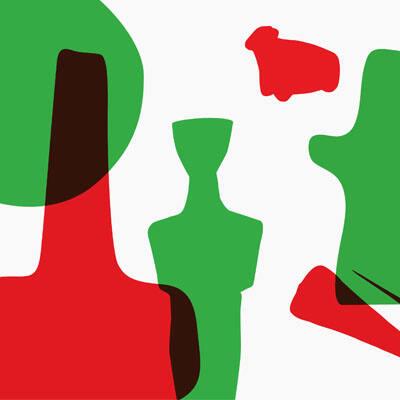Ειδώλιο
Μαρμάρινο κυκλαδικό ειδώλιο με ίχνη χρώματος
Χρονολόγηση2700-2400/2300 π.X.
Date
2700-2400/2300 BC
ΥλικόΛευκό μάρμαρο
Medium
White marble
Διαστάσεις35.5εκ.
35.5 cm
ΤαξινόμησηΛίθινα
Stonework / Plastic
Αριθμός ΑντικειμένουΝΓ0252
Object Number
ΝΓ0252
ΠερίοδοςΠρώιμη Εποχή του Χαλκού
Period
ΠεριγραφήΕιδώλιο γυναικείας μορφής κανονικού τύπου, της παραλλαγής Σπεδού. Το κεφάλι είναι δυσανάλογα μεγάλο σε σχέση με το υπόλοιπο σώμα, στο οποίο κυριαρχεί η γαμψή μύτη. Στο σώμα αποδίδονται μικροί μαστοί, τα χέρια διπλωμένα στη κοιλιά και εγχάρακτο ηβικό τρίγωνο. Το ειδώλιο παρουσιάζει μεγάλο ενδιαφέρον, καθώς τα μεγάλα αμυγδαλόσχημα μάτια, τα τοξωτά φρύδια και τα μαλλιά, που δηλώνονται με μια στενή ταινία κατά μήκος του μετώπου, αποδίδονται με ανάγλυφο τρόπο. Ωστόσο, οι λεπτομέρειες αυτές θα ήταν κάποτε επιζωγραφισμένες. Ίχνη ερυθρού χρώματος διατηρούνται στην αριστερή πλευρά, καθώς και στον δεξιό μηρό του ειδωλίου.Early Bronze Age
Description
DescriptionFemale figurine of the canonical type, Spedos variety. The head with the prominent bendy nose, is disproportionately large in relation to the rest of the body. Small breasts, arms folded on the belly and incised pubic triangle are rendered on the body. The figure is of particular interest, as the large almond-shaped eyes, arched eyebrows and hair, shown by a narrow band along the forehead, are rendered in relief. However, these details would once have been painted on with colour. Traces of red are preserved on the left side, as well as on the right thigh of the figurine.
In ancient times, figurines were not white but coloured and even brightly so. In this particular figurine the eyes, eyebrows, mouth and hair seem to have been covered with colour. Some figurines still show traces of paint, as research has shown. However, we cannot see them without special lighting and a microscope. The ancient Cycladic people mainly used red and blue colors, which were made from colored rocks.
Τα ειδώλια στα αρχαία χρόνια δεν ήταν λευκά αλλά χρωματισμένα και μάλιστα έντονα. Στο συγκεκριμένο ειδώλιο τα μάτια, τα φρύδια, το στόμα και τα μαλλιά φαίνεται πως ήταν καλυμμένα με χρώμα. Σε κάποια ειδώλια διακρίνονται ακόμη ίχνη χρώματος, όπως έχουν αποδείξει οι έρευνες. Δεν μπορούμε όμως να τα δούμε χωρίς ειδικό φωτισμό και χωρίς μικροσκόπιο. Οι αρχαίοι Κυκλαδιτες χρησιμοποιούσαν κυρίως το κόκκινο και το μπλε και για να τα φτιάξουν χρησιμοποιούσαν χρωματιστά πετρώματα.
The Cycladic figurines appeal to the modern viewer among other features also because of the austerity of the stark white marble. However, in reality, many of these sculptures were brightly coloured. Cycladic craftsmen used pigments (black or dark blue, red and, rarely green) to indicate the facial features, the hair, the pubic triangle, jewellery as well as vague symbols, that may represent body painting or tattooing. Over the centuries, most traces have been lost, but faint remnants are preserved, revealing this extremely interesting artistic practice. There are various interpretations of the colour decoration on Cycladic figurines. Since many of them come from graves, some scholars believe that the painted motifs may reflect the decoration of the deceased or of the mourners. Others believe that they are distinctive of high-status individuals, such as seafarers, merchants and specialist craftsmen. Furthermore, other scholars suggest that the repetition of specific motifs may have functioned as an expression of cultural identity, while their variations may be due to the use of figurines on different occasions or in rituals.
Τα κυκλαδικά ειδώλια γοητεύουν τον σύγχρονο θεατή μεταξύ άλλων και για τη λιτότητα που αποπνέει η λευκότητα του υλικού τους. Γνωρίζουμε, ωστόσο, ότι στην πραγματικότητα πολλά από αυτά ήταν έντονα χρωματισμένα. Οι Κυκλαδίτες τεχνίτες χρησιμοποιούσαν χρώματα (μελανό ή βαθυγάλαζο, κόκκινο και, σπανιότερα, πράσινο) για να αποδώσουν τα χαρακτηριστικά του προσώπου, τα μαλλιά, το ηβικό τρίγωνο, κοσμήματα καθώς και ασαφή σύμβολα, που πιθανώς υποδήλωναν διακόσμηση σώματος ή δερματοστιξία. Με την πάροδο των αιώνων τα περισσότερα ίχνη χάθηκαν, διατηρούνται όμως αμυδρά υπολείμματα, που αποκαλύπτουν αυτήν την εξαιρετικά ενδιαφέρουσα καλλιτεχνική πρακτική.














